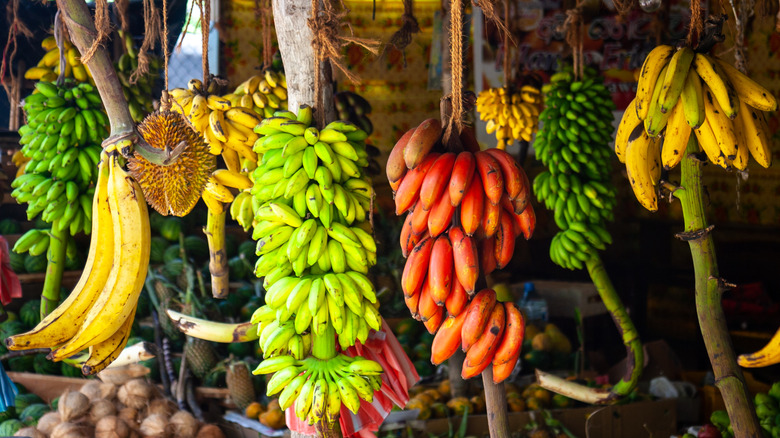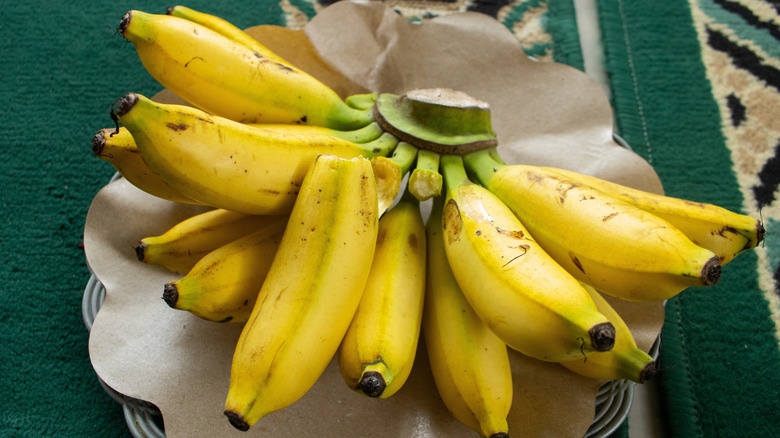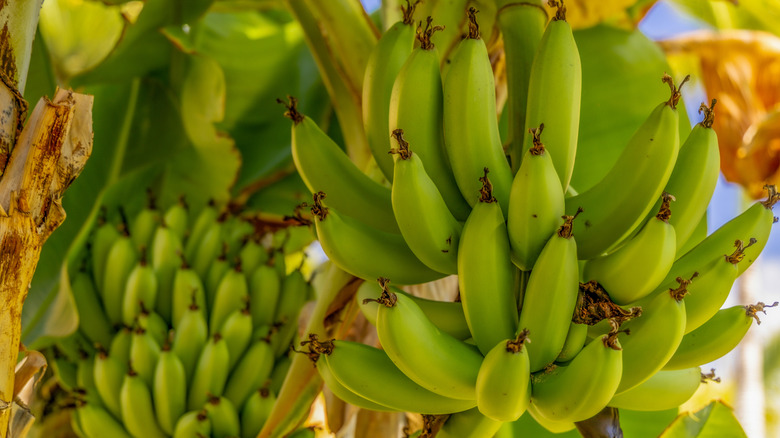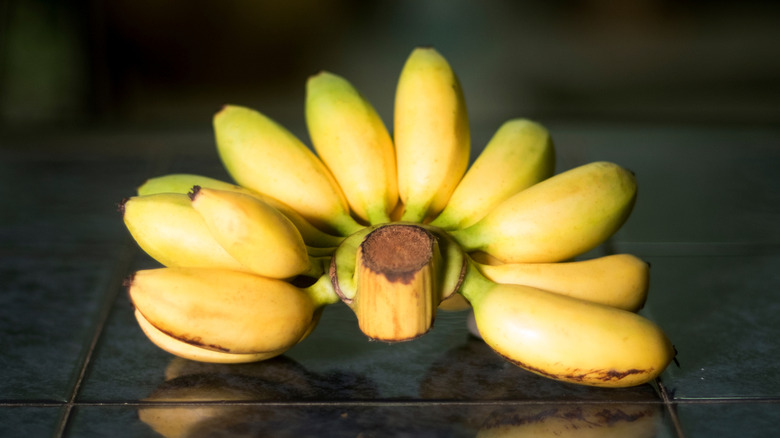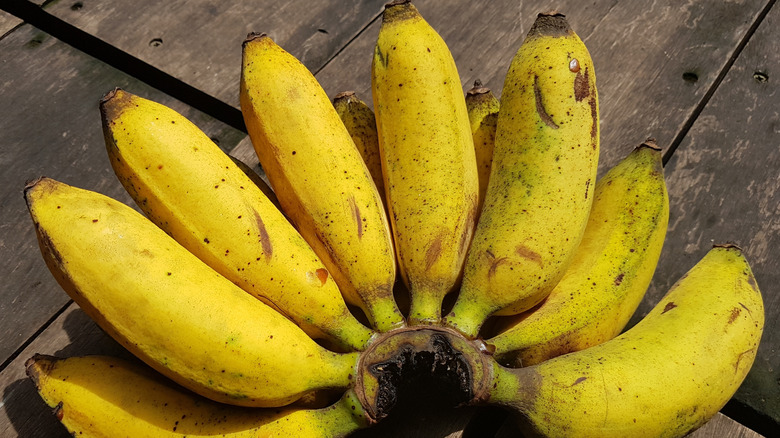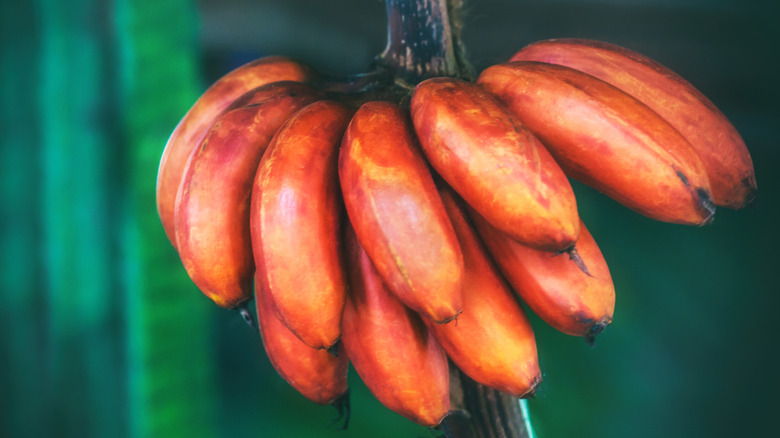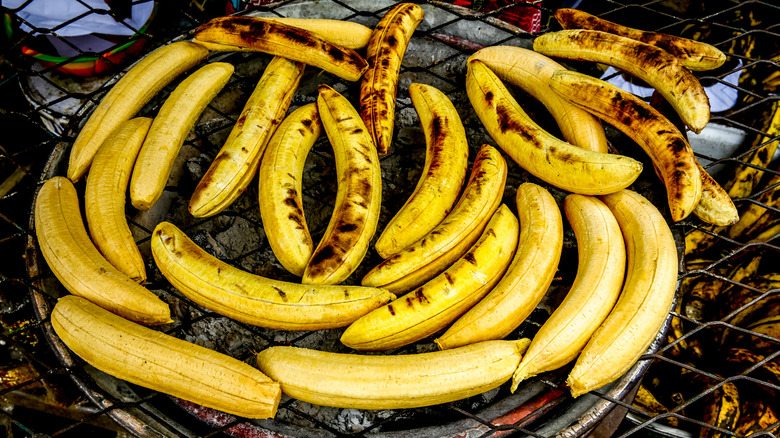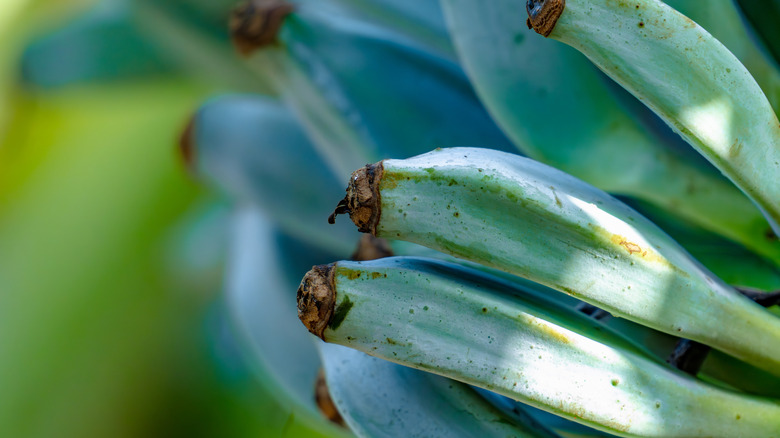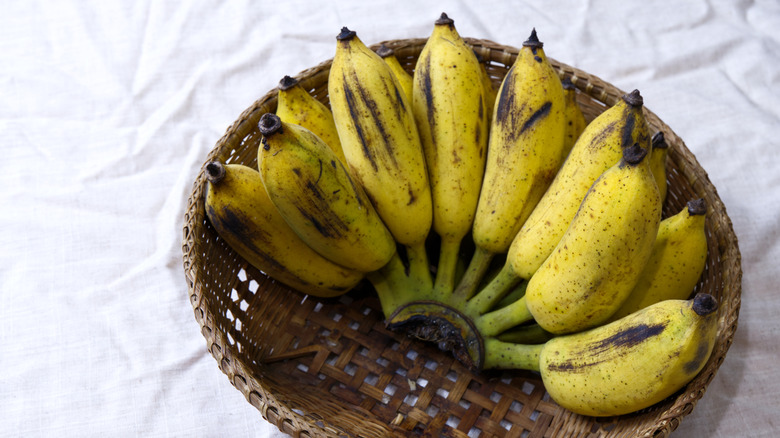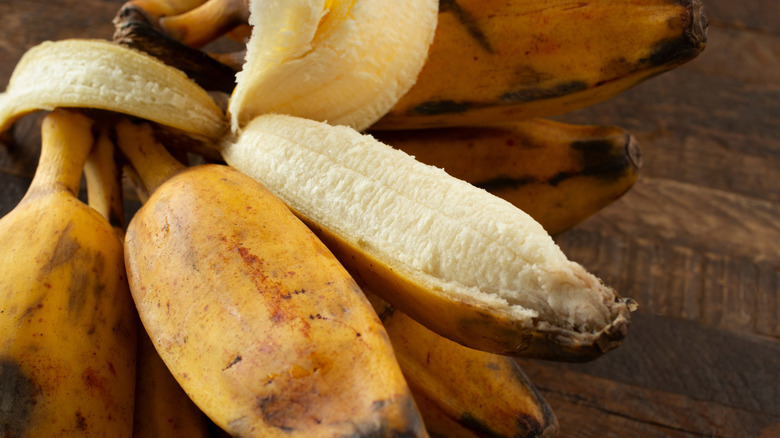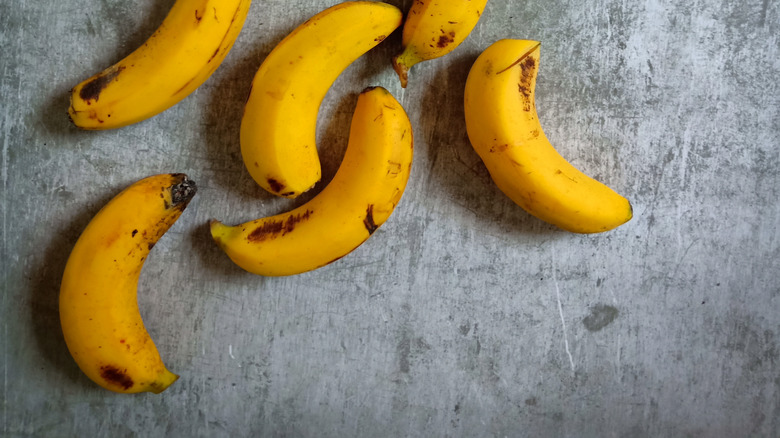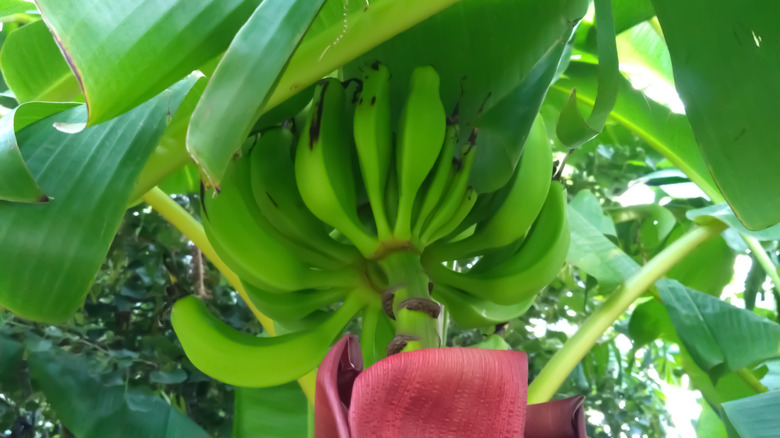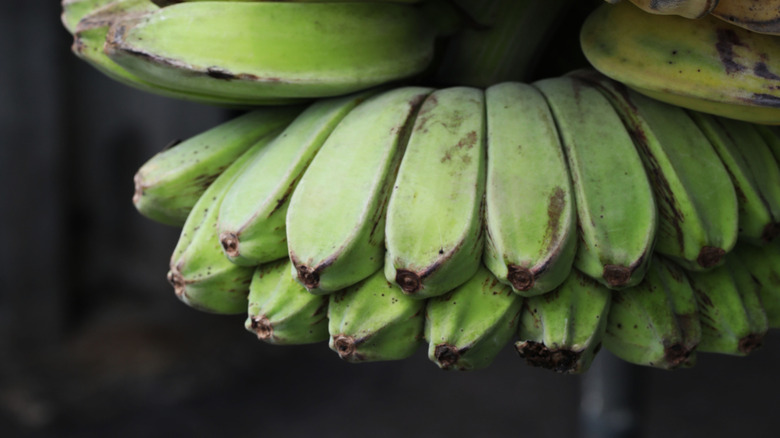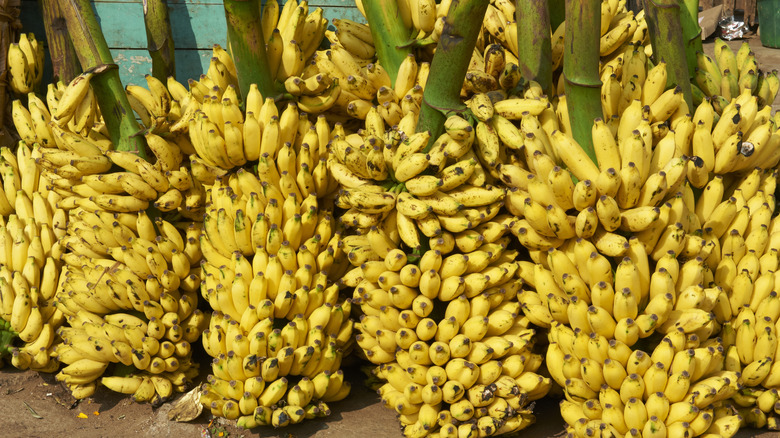13 Types Of Bananas You'll Wish You Tried Sooner
We may receive a commission on purchases made from links.
Most of us simply grab bananas from the grocery store without a second thought. We look at the bunches, pick one that's ripeness matches our preference, and move on. Do you even know what kind of bananas you're grabbing, or that there are more than 1,000 different varieties of the fruit? The answer to the first question is most likely no. Sure, you've probably heard of plantains before, even if you've never tried them, but most of us don't know much about bananas. It's time to fix that, though.
From red bananas to Blue Java to Lady Finger to Cavendish (spoiler alert: It's the most common in the United States), a world of tasty bananas is waiting to be explored. Whether you are curious about all the different flavors bananas offer or simply want to make the most delicious banana split around, knowing a bit about different types of bananas will certainly point you in the right direction.
Keep reading to learn about tasty banana varieties, and who knows? Maybe the next time you're at the grocery store your interest will be piqued enough that you seek a lesser-known variety. At the very least, you'll know a lot more about the trusty Cavendish banana.
Apple bananas
The term apple banana refers to a subset of various smaller bananas, including Manzano, Tundan, Silk, and Latundan bananas. Regardless of the exact variety, apple bananas are known for their unique taste, which does in fact have a slight apple-like flavor. Some say they have a hint of strawberry, too. The taste is a touch tangy, but it is also quite sweet, earning them the title of a dessert banana. So, if you like your banana bread to taste more like cake than bread, apple bananas are ready to help.
Unlike a common grocery store banana, apple bananas are best eaten after the skins turn completely black, or at the very least have lots of black spots. This may seem counterintuitive, but if you eat apple bananas while the skin is still yellow, the flavor isn't so great. However, if you're patient and wait to eat them until the skins look rotten, you get rewarded with the sugary tropical flavor that puts these bananas on the map.
Unfortunately, you probably won't find apple bananas at your local grocery store, unless you live in Hawaii. They are pretty common there. However, you might have some luck at farmer's markets or Asian and Latin American grocers. If that sounds like too much of a search, you can always order them from Amazon, too.
Cavendish bananas
As the most common type of banana in the United States, Cavendish bananas are what most people are familiar with. You can find them in any grocery store and there's basically zero chance you haven't tried and bought them before. In case there's any question, Cavendish bananas look just like the emoji. They are long, somewhat slender. and the skins are bright yellow, at least when ripe. Before that they are green and once they become over-ripe, dark spots develop and spread until the entire thing is black.
The popularity of Cavendish bananas in the U.S. is credited to its disease resistance and year-round availability. Of course, the classic banana flavor goes a long way, as well, but it feels like a chicken and egg scenario. Did it become popular because of its classic banana flavor? Or, do we think of it as having a classic taste because of its widespread enjoyment?
Unfortunately, there's potential for Cavendish bananas to experience what has been dubbed the banana problem. While the topic is quite nuanced, it revolves around Cavendish bananas not being grown from seeds and their susceptibility to certain diseases. Fortunately, the banana problem hasn't affected the U.S. (which are typically grown in Latin America) yet, but experts warn that there is potential for the variety to be wiped out in the future.
Lady Finger bananas
Lady Finger bananas are straighter and more cigar-shaped than your typical banana. At between 7 and 10 centimeters long, they are much shorter, too. Even so, they still have the bright yellow skins and paler yellow flesh we are accustomed to. Interestingly, they also have bright yellow seeds in the center.
A distinct trait of Lady Finger bananas is their aromatic fragrance, which is not only stronger than most bananas but deliciously sweet. Similar to the smell, the flesh has a sweet taste that everyone should try at least once. It has a touch of tartness, but vanilla, caramel, and honey flavors shine through, as well. Yum! To top it off, the flesh is creamy and velvety smooth, so it's a delight for all your senses.
Due to Lady Finger bananas being grown in Southeast Asia, they are not typical in the United States. Still, you may be able to find them at international markets and it could be worth it to search if you're looking to enhance your dessert recipes or smoothies. Fun fact: Lady Finger bananas don't turn brown or become mushy when sliced like other varieties, so they are perfect for dishes like fruit salad. They are also great enjoyed raw.
Pisang Raja bananas
Pisang Raja bananas are another variety that tastes super sweet when ripe. They are also incredibly creamy and lack the starchiness you find with many other bananas. The fruit is slightly fuzzy and interestingly, the flesh is orange colored. Just one look at it and you get a sense of its impending sweetness, even before you get a taste. The tropical aroma Pisang Raja bananas emit also gives them an alluring appeal.
Pisang Raja plants grow super-quick, making them a favorite for home gardens or use as decoration. They also produce extra large bunches, giving you a lot of bang for your buck. In addition to being called Pisang Raja bananas, you'll also find them being called Grindy, Belle, or King bananas. No matter what you hear them being called, you'd be wise to give them a try if you ever encounter them. Heck, people like their deliciously sweet taste and aroma and creamy texture so much that you might want to attempt growing a tree yourself. Apparently, it only takes a year and a half to fruit, and that's pretty quick compared to many other fruit trees.
Red bananas
Red bananas may sound like some kind of mythical fruit, but they are in fact a real thing and they are quite popular around the world. Compared to your typical grocery store banana, which we now know are Cavendish bananas, they are slightly smaller and sweeter. The flesh ranges from white to light pink and its sweetness has been credited to a mild raspberry flavor. The skins are red, as the name suggests, but as they ripen they become a deep shade of purple.
As far as bananas go, red ones are pretty nutritionally dense. They contain lots of magnesium, B6, and vitamin C. They are also packed full of fiber antioxidants, and essential minerals. All of the nutrients combined contribute to a slew of benefits, including lowered blood pressure, heart health, improved digestive health, and immune system support.
Since red bananas are primarily grown in Southeast Asia, they can be tricky to track down stateside. So, where can you find these healthy eye-catching bananas? You may be able to order a bunch from Etsy. Otherwise, you might have to resort to buying a tree from Amazon and growing it yourself if you want to get a taste of these awesome bananas. Just make sure to buy one that produces edible fruit. Many options sold online are just ornamental.
Plantains
Plantains, also known as cooking bananas, are not typically eaten raw. Unlike other types of bananas, plantains are almost always cooked before being eaten. Maybe it's because they are larger, firmer, and thicker than other types of bananas, or maybe it's just because they taste so darn good when cooked. Either way, if you've never tried plantains, now's the time to start.
While not super well-known in American cuisine, plantains are extremely popular in Caribbean, Latin American, African, and Southeast Asian recipes. They are slightly sweet, like a regular Cavendish banana, but they lack the bold banana flavor, making them great for incorporating into a world of dishes. Don't get it twisted, plantains can be eaten raw, but considering how perfectly they crisp up when fried and the delicious layer of texture they add to dishes, many people choose to cook them, instead.
Lucky for us, you can often find plantains at many grocery stores in the U.S., especially health food stores or Latin American grocers. If you buy some, wait until the skins are mostly black before eating them as that's when they taste the best. Looking for ideas of what to make with them? They make delicious vegan tacos, can be sliced and fried to create crispy plantain chips, are delicious roasted with poblano guava sauce, turned into plantain croquettes stuffed with pancetta, and the list goes on.
Blue Java bananas
Like so many other banana varieties Blue Javas are native to Southeast Asia. However, they are in a class all their own when it comes to flavor and color. As the name proudly proclaims, Blue Java bananas have an eye-catching light bluish-green color. You'll also hear people calling them ice cream bananas because that's what they taste like. Um... what? Sounds too good to be true, but it's not. Blue Javas have a delicious vanilla flavor that reminds people of ice cream, so obviously, they are perfect for dessert recipes. The creamy texture of these bananas is also similar to ice cream, so the nickname is well-deserved.
Blue Java bananas sound amazing, right? Well, you're not the only one who thinks so, and finding some of them can be quite challenging. Don't even bother looking for them at grocery stores; even specialty ones don't carry them. You might be able to grow a tree if you live in a particularly hot and humid climate, but that counts most people out. If you really want to taste an ice cream banana, you'll have to pay a pretty penny for it and it won't be easy to get your hands on. However, you can order Blue Java bananas from online vendors.
Ducasse bananas
Sweet and slightly fruity, Ducasse bananas are a tasty dessert banana variety. They look a lot like a typical banana, but smaller and they start green and become bright yellow as they ripen. Ducasse bananas also have angular skins but circular flesh inside. They are originally from Southeast Asia, Thailand to be exact, and are known by many regional names, including sugar or Thai bananas.
Ducasse bananas may not be super well-known in the United States, but in Southeast Asia, they are one of the most commercially grown varieties of the fruit. In addition to the region in which they are grown, Ducasse bananas are pretty popular in Australia because they store well. People also love their sweetness, which is more prominent than with Cavendish bananas (which are also popular in Australia). In fact, Australians love Ducasse bananas so much that in 2015, they were the preferred variety in the country's long-standing annual competition: The Banana Cup.
Thanks to the smaller size of Ducasse banana trees, they are great for small gardens. They can even thrive in a pot on a patio. They still need lots of care, but if you aren't traveling to Australia or Southeast Asia anytime soon, growing a tree may be the only way to get your hands on these small dessert bananas. There's a chance you might be able to find them at an Asian market, but it's not likely.
Burro bananas
Compared to the typical Cavendish banana, Burro bananas are much smaller and flatter. Both the skin and the flesh also have a distinct square-like shape. In addition, the flesh is creamy but it gets firmer towards the center. The texture makes them good for all kinds of enjoyment. When firmer, they are perfect for slicing and cooking. Once more softened, you can use them just like a typical banana and turn them into a mash, banana bread, or simply put them on top of your favorite breakfast dish.
Unlike most of the other banana varieties we have discussed, Burro bananas come to us from Mexico, but that shouldn't be too surprising considering its name. As Burro bananas ripen, they develop a netting of brown or black spots. Don't let that deter you, though — you don't need to toss them out when this happens. Actually, the more ripe they become, the better the flavor gets. When mature, they taste mildly sweet and fruity with a tantalizing element of lemon. If you want to make the most of the lemony flavor, younger Burro bananas are your best bet. Another interesting thing about Burro bananas is that they have small black seeds inside. They are edible though, so there's no need to pick them out.
Pisang Berangan bananas
Pisang Berangan bananas may look a lot like your average banana, but they offer a unique taste that makes them stand out from the crowd. As opposed to the normal sweet flavor, they have a balanced sweet and sour taste with tropical elements and a light acidity. As Pisang Berangan bananas age, the skins change from green to yellow. After that, they start to develop small dark spots and a somewhat orange hue.
Pisang Berangan bananas are Malaysian and experts speculate they have been growing wild in the country since ancient times. A lack of historical records makes this hard to say with certainty, but there's no doubt they have been popular there for many years. Today, they are also one of the most cultivated bananas in the country. However, more recently the variety has been plagued with disease. In an effort to ensure its ability to survive in the future the Malaysian government is working closely with scientists to develop a more resistant hybrid, and their work includes more than just the Pisang Berangan banana.
It's unlikely you'll find Pisang Berangan bananas being sold in the United States, unless you know someone growing them in their garden. However, if you're ever in Malaysia, Singapore, Hong Kong, or the Middle East, you just might be able to get your hands on a bunch.
Goldfinger bananas
Goldfinger bananas are a new semi-dwarf variety created by a banana breeding project in Honduras. They are a cross of Cavendish and Lady Finger bananas and they show a lot of potential for commercial production. Not only are they tasty, but they also excel in the realm of disease and high wind resistance. Plus, Goldfinger bananas tolerate some cold, so the plants are pretty darn hardy and resilient overall.
In addition to commercial potential, Goldfinger bananas have a creamy texture and fantastic flavor. They are noticeably sweet with underlying elements of apple, pineapple, and orange shining through. The flavor is the best when ripe but you can also boil or fry green Goldfinger bananas and add them to other dishes. Unlike most banana varieties, they don't turn brown after slicing either, making them perfect for fruit salads and other fresh recipes. For now, you'll probably have to grow Goldfinger bananas yourself if you want to get a taste of them, but considering the trees' hardy nature, we wouldn't be surprised if commercial growers started taking advantage of their benefits in the future.
Praying hands bananas
Praying Hands bananas have a unique appearance all their own. While they do develop slender banana fruits, they grow in rows and all the bananas fuse together to form one giant bunch that looks like two hands pressed together in a prayer position. When ripe, the skins have a leathery, brittle texture, but still come off easily. You don't have to eat the entire bunch as one fruit either because the "fingers" can be separated without damaging the rest of the bananas.
Praying Hands bananas are soft and slightly starchy with a chewier center than most varieties. They also contain a few black seeds, but they aren't hard enough to interrupt enjoyment. As far as flavor is concerned, Praying Hands bananas possess hints of lemon, vanilla, and grass but they are slightly sweet and tropical overall. Aside from looking super cool and having a layered flavor, Praying Hand bananas also resist browning after slicing — score!
In Southeast Asia, these fun bananas have been eaten since ancient times, but here in the States, they are still quite rare. Specialty growers are your only option if you want to track some down, don't expect it to be easy, though.
Mysore bananas
Short and plump, Mysore bananas are pretty adorable, but that's not all they have to offer. They also have a creamy yet chewy texture and a complex flavor. As dessert bananas, they are pretty sweet. However, they also have a tangy, acidic element paired with hints of candy and berries. Compared to other dessert bananas, Mysore is a touch starchier, but not in a bad way. They also have a sweet and sour aroma that reflects their nuanced taste.
Native to Southern India, Mysore bananas are highly cultivated. The plants are quite hardy and resistant to both disease and drought. They also have strong root systems, making them a favorite of growers in the region. Thanks to traveling merchants and migrants, Mysore bananas have also spread to tropical and subtropical regions around the world. Even so, they are still pretty rare in the United States, so again, specialty growers are your best bet.

